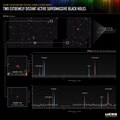File:Two Extremely Distant Active Supermassive Black Holes (NIRSpec MSA Emission Spectra) (2023-114).png

Original file (3,840 × 3,825 pixels, file size: 4.52 MB, MIME type: image/png)
Captions
Captions
Summary
[edit]| DescriptionTwo Extremely Distant Active Supermassive Black Holes (NIRSpec MSA Emission Spectra) (2023-114).png |
English: Researchers using data and images from the James Webb Space Telescope have already captured two of the smallest known supermassive black holes in the early universe.
Webb’s spectra show that these black holes weigh only 10 million times the mass of the Sun. Other very distant supermassive black holes we’ve known about for decades are over 1 billion times the mass of the Sun. These two are so small that they are closer to the size of Sagittarius A*, the supermassive black hole at the center of our Milky Way galaxy, which is 4.6 million times the mass of the Sun. “Researchers have long known that there must be lower mass black holes in the early universe,” explained Dale Kocevski of Colby College in Waterville, Maine, who led this research as part of the Cosmic Evolution Early Release Science (CEERS) Survey. “But Webb is the first observatory that has captured them so clearly.” Unmistakable signatures of the distances to their host galaxies are in each spectrum above: Three lines appear in the same order – one hydrogen line followed by two ionized oxygen lines. Where this pattern falls reveals the redshift of the two targets, showing researchers how long ago their light was emitted. The first spectrum proves black hole CEERS 2782 existed only 1.1 billion years after the big bang, emitting its light 12.7 billion years ago. Webb’s data also show it is clear of dust. The second, CEERS 746, existed slightly earlier, 1 billion years after the big bang, but its bright accretion disk is still partially clouded by dust. “The central black hole is visible, but the presence of dust suggests it might lie within a galaxy that is furiously pumping out stars,” added Kocevski. The researchers found this pair of extremely distant black holes while carefully reviewing images from the CEERS Survey – and followed up to learn their precise makeup with Webb’s microshutter array aboard NIRSpec (its Near-Infrared Spectrograph), which produced the definitive spectra above. Webb was immediately able to clearly detail some of the most distant black holes yet known, which has already opened a vast new region of research. These black holes existed toward the end of the Era of Reionization, when the universe was cast in a dense “fog.” With its infrared observations, Webb can capture plenty of light from objects that existed during this period, which is why researchers are so excited to continue reviewing the CEERS data. “We don’t yet know how the earliest black holes formed in the universe,” said Steven Finkelstein of the University of Texas at Austin, who leads this program. “With Webb, we can now start to systematically search for them and begin untangling this mystery.” NIRSpec was built for the European Space Agency (ESA) by a consortium of European companies led by Airbus Defence and Space (ADS) with NASA’s Goddard Space Flight Center providing its detector and micro-shutter subsystems. NASA, ESA, CSA, Leah Hustak (STScI) Steve Finkelstein (UT Austin), Dale Kocevski (Colby College), Pablo Arrabal Haro (NSF's NOIRLab) |
| Date | 6 July 2023 (upload date) |
| Source | Two Extremely Distant Active Supermassive Black Holes (NIRSpec MSA Emission Spectra) |
| Author | Image: NASA, ESA, CSA, Leah Hustak (STScI) Science Steve Finkelstein (UT Austin), Dale Kocevski (Colby College), Pablo Arrabal Haro (NSF's NOIRLab) |
| Other versions |
|
Licensing
[edit]| Public domainPublic domainfalsefalse |
| This file is in the public domain because it was created by NASA, ESA and CSA. NASA Webb material is copyright-free and may be freely used as in the public domain without fee, on the condition that only NASA, STScI, and/or ESA/CSA is credited as the source of the material. This license does not apply if source material from other organizations is in use. The material was created for NASA by Space Telescope Science Institute under Contract NAS5-03127. Copyright statement at webbtelescope.org. For material created by the European Space Agency on the esawebb.org site, use the {{ESA-Webb}} tag. |
 |
File history
Click on a date/time to view the file as it appeared at that time.
| Date/Time | Thumbnail | Dimensions | User | Comment | |
|---|---|---|---|---|---|
| current | 10:31, 24 August 2023 |  | 3,840 × 3,825 (4.52 MB) | OptimusPrimeBot (talk | contribs) | #Spacemedia - Upload of https://stsci-opo.org/STScI-01H28X2YX4JNCFE3XFX39YPDKK.png via Commons:Spacemedia |
You cannot overwrite this file.
File usage on Commons
There are no pages that use this file.
Metadata
This file contains additional information such as Exif metadata which may have been added by the digital camera, scanner, or software program used to create or digitize it. If the file has been modified from its original state, some details such as the timestamp may not fully reflect those of the original file. The timestamp is only as accurate as the clock in the camera, and it may be completely wrong.
| Horizontal resolution | 28.34 dpc |
|---|---|
| Vertical resolution | 28.34 dpc |
